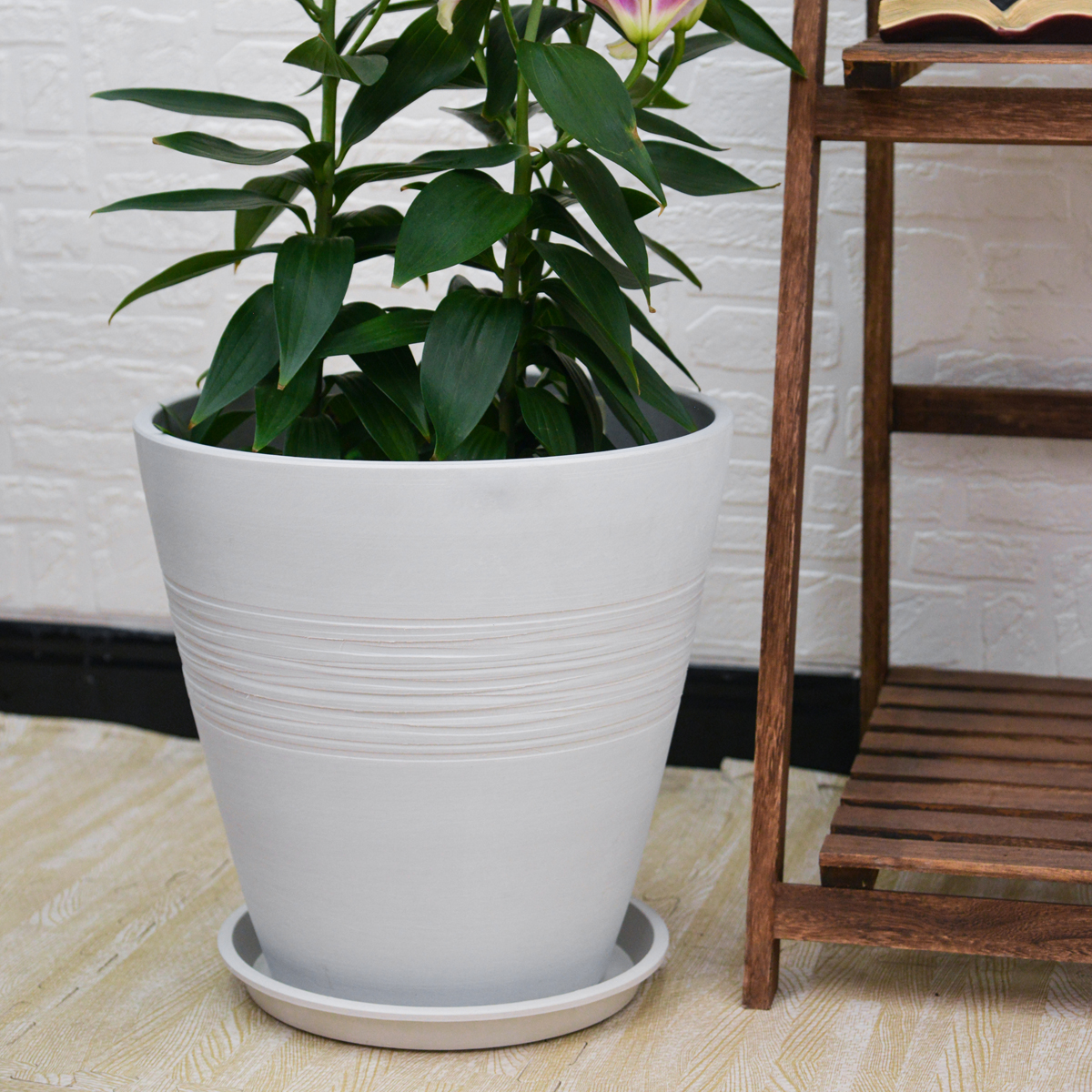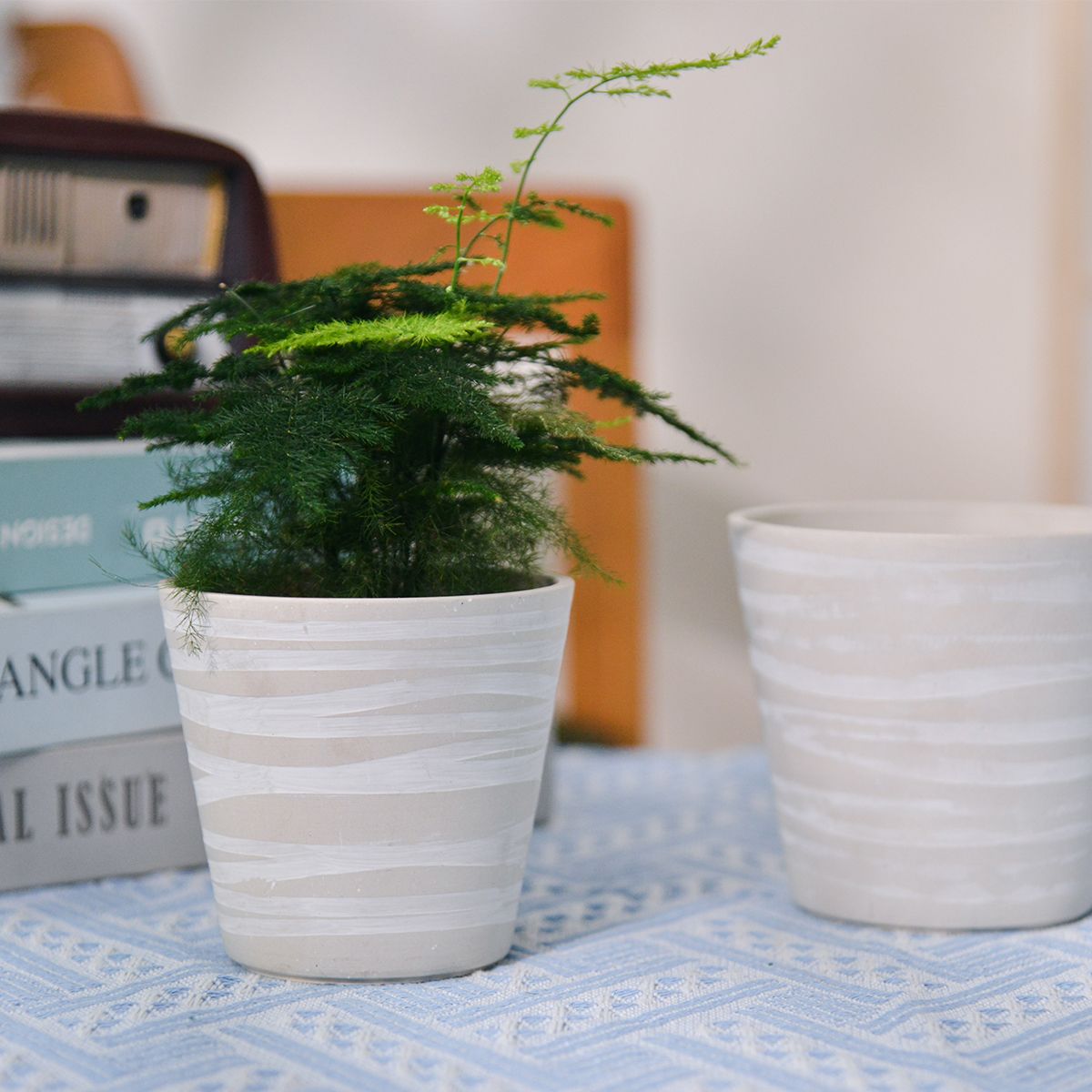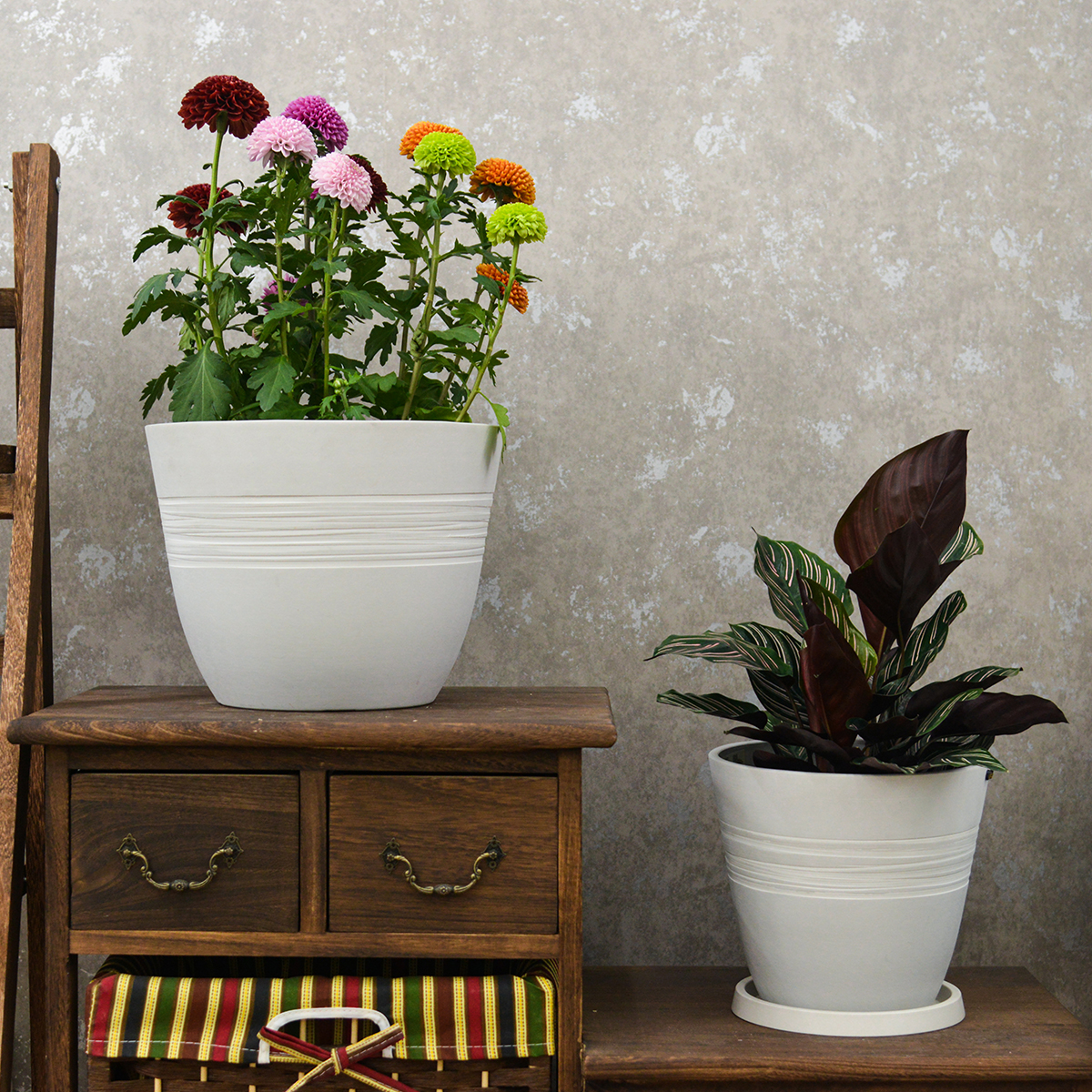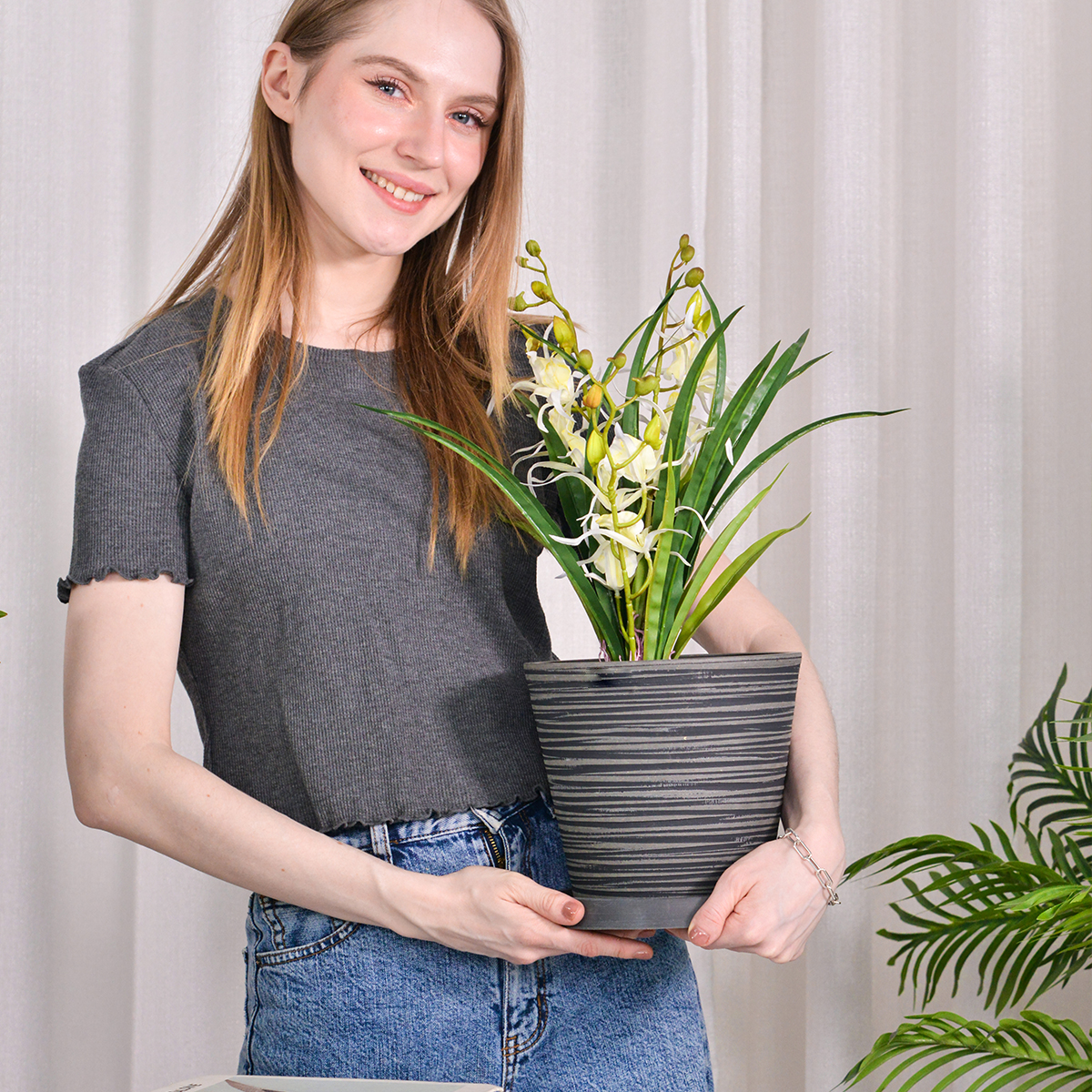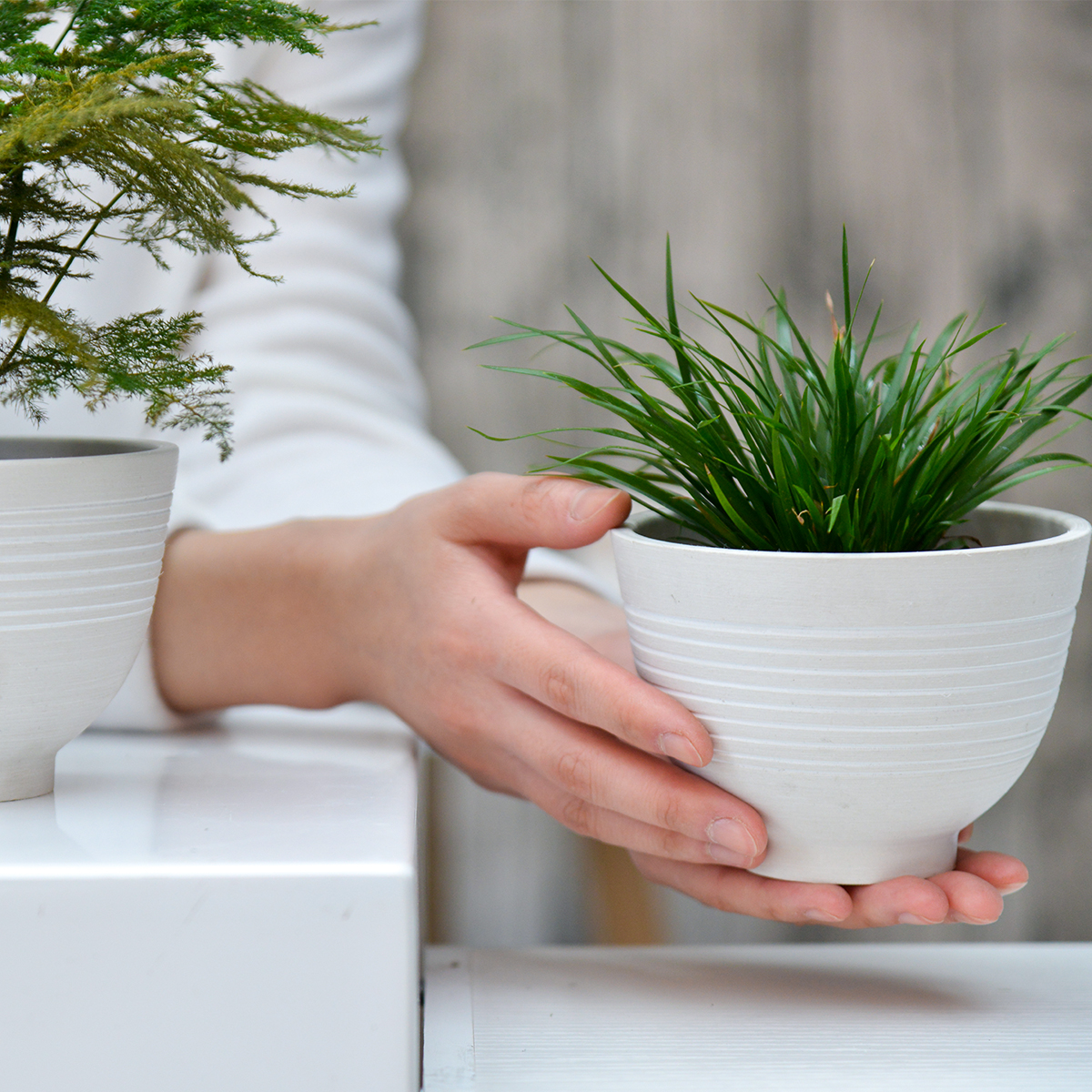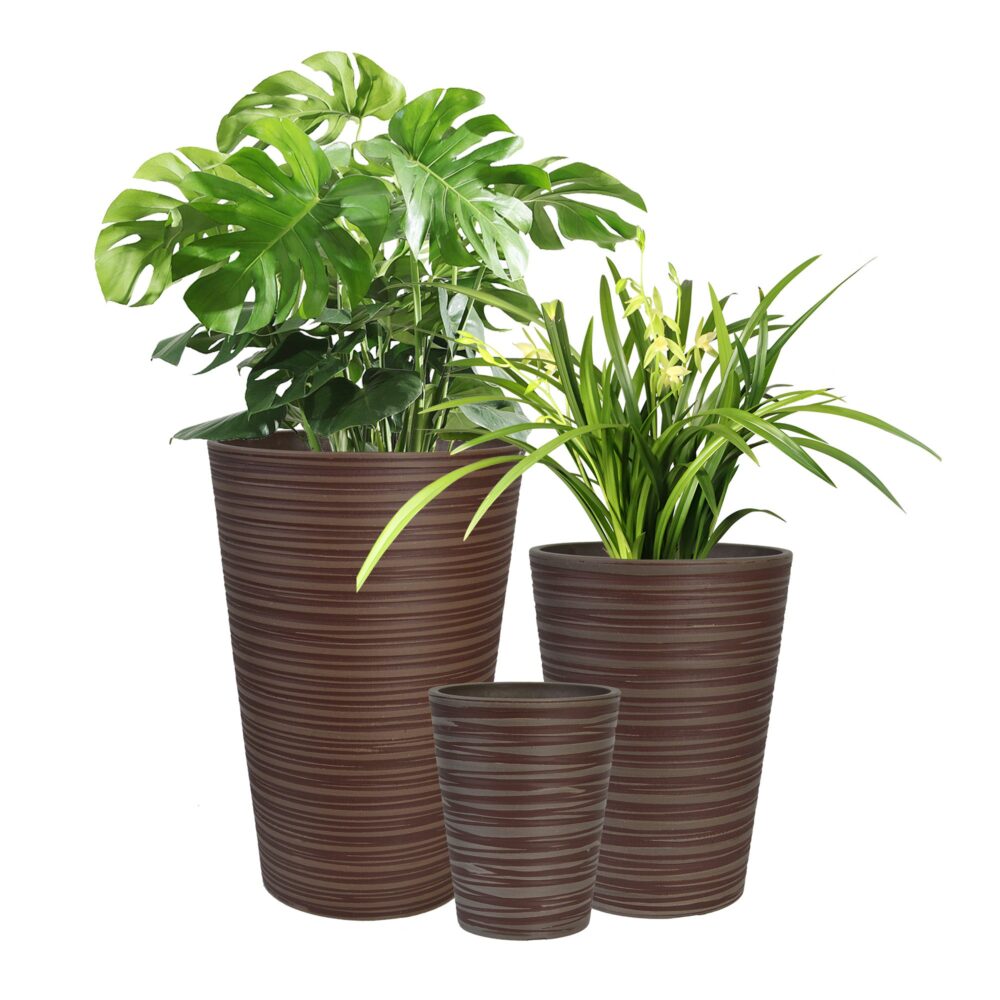Phlox in Pots: The Ultimate Guide to Growing Beautiful Phlox Outdoors in Containers
Want to fill your patio, balcony, or garden with masses of fragrant, colorful flower clusters that attract butterflies all summer long? Phlox, especially Tall Garden Phlox (Phlox paniculata) and Creeping Phlox (Phlox subulata), are wonderfully rewarding choices for outdoor container gardening. Celebrated for their long-lasting displays of vibrant flower clusters in a wide array of colors, and their sweet fragrance and attractiveness to pollinators, Phlox are perfect for adding classic cottage garden charm to sunny outdoor spaces. This comprehensive guide will provide you with everything you need to know to grow Phlox successfully in outdoor pots, from selecting the best varieties and containers to mastering essential care techniques for a season filled with Phlox beauty and fragrance.
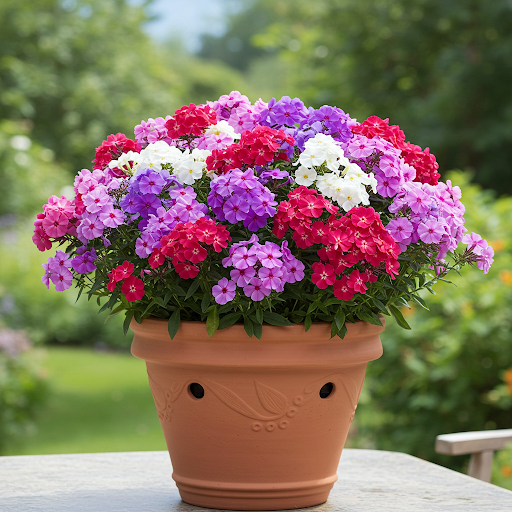
Phlox
What are Phlox?
Phlox, commonly known as Phlox or Summer Phlox (for Phlox paniculata) and Creeping Phlox (for Phlox subulata), is a genus of herbaceous flowering plants in the Polemoniaceae family (phlox family). Native primarily to North America, with some species in Asia and Europe, Phlox are popular perennials and annuals grown for their abundant clusters of fragrant, colorful flowers and long blooming season. Phlox flowers are famous for their clusters of five-petaled, often sweetly scented florets, typically in shades of pink, purple, lavender, red, salmon, orange, blue, and white. The flower clusters can be rounded, dome-shaped, or more elongated panicles, depending on the species and variety. Phlox plants exhibit diverse growth habits, from upright and tall (Tall Garden Phlox) to low-growing and spreading (Creeping Phlox), ranging in height from just a few inches to over 4 feet tall, depending on the species and variety. They are known for their sweet fragrance, vibrant colors, long blooming season (spring to fall, depending on type), sun-loving nature, and strong attractiveness to butterflies and hummingbirds, making them an invaluable addition to gardens and containers, especially for adding classic cottage garden charm and attracting wildlife.
Are Phlox Good for Outdoor Pots?
Yes, Phlox, especially certain types like dwarf Tall Garden Phlox and Creeping Phlox, are exceptionally well-suited for outdoor pots and container gardening. Their long blooming season, adaptable growth habits, tolerance of sunny locations, and beautiful, fragrant flower clusters make them ideal for filling pots, window boxes, and mixed container arrangements with classic cottage garden style. Phlox thrive in sunny locations and bloom profusely throughout the warm season, providing a long-lasting and delightful floral display in containers. Their relatively easy-care nature and beautiful, fragrant blooms make them a fantastic and rewarding choice for container gardens of all styles, especially for adding a touch of traditional elegance to patios, balconies, and decks. Growing Phlox in pots also allows you to easily move them to optimal locations and control their growing conditions, especially soil moisture and drainage.
Ideal Growing Conditions for Phlox in Pots:
Types of Phlox for Pots: While many Phlox species exist, the most popular and suitable for pots are generally Tall Garden Phlox (Phlox paniculata) and Creeping Phlox (Phlox subulata), and their various cultivars. Consider your desired height, bloom time, and growth habit when choosing:
- Dwarf Tall Garden Phlox: (Phlox paniculata dwarf types) – Compact and smaller in stature, typically under 1.5-2 feet tall. Ideal for medium pots, mixed containers, and smaller spaces. Known for their upright but compact habit, fragrant flowers, and mildew resistance (in many newer varieties). Excellent for bringing the classic Phlox look to containers without overwhelming them. Look for varieties in the ‘Fashionably Early’ series, ‘ Luminary Series’, ‘Super Compact Series’, and ‘Glamour Girl’.
- Creeping Phlox: (Phlox subulata) – Very low-growing and spreading, typically only 4-6 inches tall but spreading 1-2 feet wide. Ideal for window boxes, hanging baskets, rock gardens, and spilling over pot edges. Known for their early spring bloom in masses of small, star-shaped flowers, and evergreen foliage. Excellent for early season color in containers and for creating a cascading effect. Look for varieties in various colors like ‘Emerald Blue’, ‘Crimson Beauty’, ‘Candy Stripes’, and ‘Snowflake’.
- Hybrid Phlox for Containers: (Modern Phlox hybrids bred for pots) – Many newer Phlox hybrids are specifically bred for container performance, with improved mildew resistance, compact habits, and continuous blooming. Look for series like the ‘ интенз Pink’ series, ‘ непрерывный Series’, and other modern hybrid cultivars labeled as “container phlox” or “dwarf mildew resistant phlox”. These often offer the best traits for pot culture.
- Other Phlox Species (with caution): Some other Phlox species, like Phlox divaricata (Woodland Phlox) or Phlox maculata (Wild Sweet William), can be grown in larger pots in partial shade, but are generally less common in containers than Phlox paniculata and Phlox subulata. If trying other species, research their specific needs and pot suitability.
Light: Phlox thrive in full sun to partial shade. Tall Garden Phlox (Phlox paniculata) perform best in full sun (6-8 hours of direct sunlight) to bloom profusely and help prevent powdery mildew. Creeping Phlox (Phlox subulata)also prefer full sun for best flowering, but can tolerate light afternoon shade, especially in hotter climates. Choose a sunny location for your Phlox containers, such as a south-facing patio, balcony, or garden bed. In too much shade, Tall Garden Phlox are very prone to powdery mildew, and both types will bloom less profusely and may become leggy.
Soil: Phlox need well-draining soil that is rich in organic matter and consistently moist. Use a high-quality potting mix specifically formulated for containers or flowers. Amend potting mix with compost, peat moss, or well-rotted manure to improve drainage, aeration, and nutrient content, and moisture retention. Phlox appreciate consistently moist soil, especially Tall Garden Phlox, but good drainage is also crucial to prevent root rot. Avoid heavy, compacted soil or garden soil in pots, as they can become waterlogged. A slightly acidic to neutral pH (around 6.0-7.0) is ideal for most Phlox.
Watering: Phlox, especially Tall Garden Phlox, prefer consistently moist soil, especially during active growth and blooming periods. Water thoroughly when the top inch of soil feels slightly dry. Water deeply until water drains out of the drainage holes. Maintain even soil moisture, but avoid letting pots sit in standing water. Do not allow the soil to completely dry out, especially during hot, sunny, or windy weather, as this can stress plants, reduce flowering, and make them more susceptible to powdery mildew. Creeping Phlox are more drought-tolerant once established, but still appreciate regular watering, especially in pots. Watering frequency will depend on weather conditions, light levels, pot size, and plant size. During hot summer months, you may need to water daily or even twice a day for smaller pots in full sun or windy locations. Check soil moisture regularly and adjust watering accordingly. Water at the base of the plant to keep foliage and flowers dry and help prevent fungal diseases, especially powdery mildew on Tall Garden Phlox.
Temperature: Phlox are hardy and adaptable plants that tolerate a wide range of temperatures. Tall Garden Phlox (Phlox paniculata) are cold-hardy perennials in USDA zones 4-8. They perform best in moderate summer temperatures between 65°F to 80°F (18°C to 27°C). They can tolerate heat, but prolonged high temperatures above 85°F (29°C) can stress plants and increase susceptibility to powdery mildew. Creeping Phlox (Phlox subulata) are also cold-hardy perennials in USDA zones 3-9, and are very tolerant of both cold and heat. Check the hardiness of your specific Phlox variety if you intend to overwinter them outdoors in pots in colder zones.
Fertilizer: Phlox are moderate to heavy feeders and benefit from regular fertilization to support their long blooming season and abundant flower production, especially Tall Garden Phlox. Fertilize regularly during the growing season (spring to fall) with a balanced liquid fertilizer (e.g., 10-10-10 or 20-20-20) diluted to half strength, every 2-3 weeks. Alternatively, you can use a slow-release granular fertilizer incorporated into the potting mix at planting time, and supplement with liquid fertilizer as needed. Regular fertilization encourages continuous blooming, strong fragrance production, and healthy foliage. Avoid over-fertilizing, which can lead to leggy growth and weaker stems.
Choosing the Right Pots for Phlox:
Suitable Pot Types: Phlox are adaptable to various pot types, including terracotta, ceramic, plastic, resin, and window boxes. Consider these factors when selecting pot types for Phlox:
- Terracotta Pots: Porous, allow good aeration and drainage, and aesthetically classic. Terracotta is a good choice for Phlox as it provides good drainage and aeration, helping to prevent overwatering. However, terracotta pots also dry out more quickly, so monitor soil moisture, especially in hot weather and for moisture-loving plants like Tall Garden Phlox.
- Ceramic Pots: Available in many decorative styles, can add a decorative element to your container garden, and retain moisture reasonably well. Ensure good drainage. Choose based on your desired aesthetic and moisture retention needs. Glazed ceramic pots retain moisture better than unglazed terracotta.
- Plastic Pots: Lightweight, inexpensive, retain moisture well, and are available in various colors and styles. Excellent choice for Phlox, especially for moisture retention in sunny locations, and for larger pots that need to be moved. Choose good quality plastic pots with drainage holes. Lighter colored plastic pots may heat up less in direct sun.
- Resin Pots: Lightweight, durable, available in various styles mimicking terracotta or ceramic, and offer a balance of drainage and moisture retention. A good alternative to heavy ceramic pots, and often more durable than terracotta or plastic.
- Window Boxes: Ideal for Creeping Phlox and dwarf Tall Garden Phlox, creating long, colorful displays on windowsills or railings. Ensure window boxes have good drainage and sufficient depth for root growth.
Drainage: Good drainage is essential for Phlox to prevent root rot. Ensure your chosen pot has drainage holes at the bottom. Avoid pots without drainage holes. Adding a layer of gravel or pot shards at the base of the pot is generally not necessary if using a well-draining potting mix, but can be done for extra precaution, especially in heavier pots. Elevating pots slightly on pot feet or bricks can further improve drainage and air circulation around the base.
Pot Size: Choose pot sizes appropriate for the type and mature size of the Phlox you are planting, and the desired display. Phlox have fibrous root systems and need adequate space for healthy growth.
- Dwarf Tall Garden Phlox: For dwarf Tall Garden Phlox, pots that are 10-12 inches in diameter and at least 10 inches deep are suitable for individual plants. For mass plantings or window boxes, use larger containers or window boxes with spacing of about 12-18 inches between plants.
- Creeping Phlox: For Creeping Phlox, pots or window boxes that are 8-10 inches in diameter and at least 6 inches deep are suitable for individual plants. For hanging baskets, use baskets that are at least 10-12 inches in diameter. Allow about 12-18 inches of spacing per plant in window boxes for spreading.
- Taller Tall Garden Phlox (not generally recommended for pots): If attempting to grow taller Tall Garden Phlox in pots, use very large pots that are 16-20 inches in diameter or larger and at least 14-16 inches deepfor individual plants, or very large tubs for multiple plants. Taller Phlox need substantial root space and stability, and may still be prone to flopping in pots. Dwarf and compact varieties are much better suited for container growing.
Color and Style: Choose pot colors and styles that complement your Phlox blooms and your outdoor décor. Classic or cottage-style pots, such as terracotta, weathered stone, or painted ceramic, enhance the traditional charm of Phlox. White or pastel-colored pots can create a romantic and elegant look, especially for pastel Phlox shades. Brightly colored pots can provide a bolder contrast with white or pastel Phlox varieties. Consider the overall style of your patio or garden and choose pots that harmonize with the surroundings, and enhance the cottage garden feel you wish to create.
Essential Care Tips for Thriving Phlox in Outdoor Pots:
- Watering: “Keep Soil Consistently Moist, Avoid Drying Out”. Water thoroughly when the top inch of soil feels slightly dry. Water deeply until water drains from drainage holes. Maintain even soil moisture, but avoid soggy conditions. Do not allow soil to completely dry out, especially during hot weather. Water more frequently during hot, sunny, or windy weather, especially for Tall Garden Phlox to prevent mildew stress.
- Sunlight: Provide Full Sun to Partial Shade (6+ Hours Daily). Place Phlox pots in a location that receives full sun for best blooming and mildew prevention (for Tall Garden Phlox), or partial shade in very hot afternoon sun.
- Fertilizing: Fertilize Regularly During Growing Season. Fertilize every 2-3 weeks with a dilute balanced liquid fertilizer, or use slow-release fertilizer at planting time. Regular feeding promotes continuous blooming and healthy growth.
- Deadheading (Encourage Reblooming): Deadhead spent flower clusters regularly on Tall Garden Phlox to encourage reblooming and prevent self-seeding (if desired). Snip off faded flower heads just below the flower cluster. Creeping Phlox generally do not require deadheading.
- Pruning (Minimal Pruning Needed): Phlox generally do not require much pruning. You can lightly trim back Tall Garden Phlox after their first main bloom flush to encourage a second flush of flowers. In late fall or early spring, cut back dead foliage to the ground for Tall Garden Phlox. Creeping Phlox are evergreen and do not require pruning except to trim back spreading growth if needed.
- Staking (For Taller Tall Garden Phlox in Pots): Taller Tall Garden Phlox varieties, if grown in pots, may benefit from staking to prevent them from flopping over, particularly in windy locations or after heavy rain. Use bamboo stakes or plant supports to provide support as needed. Dwarf and compact varieties generally do not need staking.
- Overwintering (For Perennial Phlox in Cold Climates): In colder USDA zones where Phlox are hardy, potted Phlox can be overwintered outdoors. Provide some winter protection by mulching heavily around the base of the plants and moving pots to a sheltered location, such as against a south-facing wall or unheated garage, especially in very cold or exposed areas. In extremely cold zones, you may need to insulate pots further by wrapping them in burlap or bubble wrap. Check the hardiness of your specific Phlox variety.
- Dividing (Every 2-3 Years for Tall Garden Phlox): Tall Garden Phlox (Phlox paniculata) benefit from division every 2-3 years to prevent overcrowding and rejuvenate plants, and to improve air circulation and mildew resistance. Divide in spring or fall. Dig up the clump, divide the root ball into sections, and replant each section in fresh potting mix. Creeping Phlox generally do not need frequent division.
- Powdery Mildew Prevention (Especially for Tall Garden Phlox): Powdery mildew is a common fungal disease on Tall Garden Phlox, especially in humid conditions or with poor air circulation. Choose mildew-resistant varieties. Ensure good air circulation by spacing plants adequately, avoid overcrowding, water at the base of the plant, provide good drainage, and avoid overhead watering. Provide full sun if possible. Fungicides can be used preventatively or to treat mildew if necessary.
Popular Phlox Cultivars for Pots (by Type/Color/Size):
- Dwarf Tall Garden Phlox: ‘Fashionably Early Flamingo’ (pink dwarf, mildew resistant), ‘ Luminary Opalescence’ (lavender-pink dwarf, mildew resistant), ‘Super Compact Pink’ (pink dwarf, very compact), ‘Glamour Girl’ (coral-pink dwarf, mildew resistant), ‘ младший Dance’ (purple-pink dwarf)
- Creeping Phlox: ‘Emerald Blue’ (blue-lavender creeping), ‘Crimson Beauty’ (red creeping), ‘Candy Stripes’ (pink and white bi-color creeping), ‘Snowflake’ (white creeping), ‘ повстанческий Series’ (various creeping colors)
- Hybrid Container Phlox: ‘ интенз Pink’ (bright pink hybrid, container type), ‘ непрерывный Rose’ (rose-pink hybrid, long blooming), ‘ непрерывный White’ (white hybrid, long blooming), ‘ непрерывный Lavender’ (lavender hybrid, long blooming), ‘ Карибский Series’ (various hybrid colors, compact)
- Tall Garden Phlox (Taller, less ideal for pots, but some dwarf options available): Phlox paniculata (species, various colors, taller), ‘ Дэвид’ (white tall, mildew resistant), ‘ Бартендер Series’ (various tall colors, fragrant), ‘ Лаура’ (purple-pink tall, mildew resistant), ‘ Нора Leigh’ (variegated foliage, pink flowers, taller)
- Novelty Colors & Forms: ‘Blue Paradise’ (blue-purple, fragrant, taller), ‘Coral Crème Drop’ (coral-pink, unique flower form, dwarf), ‘ Watermelon Punch’ (watermelon-red, vibrant color), ‘ Jeana’ (magenta-pink, mildew resistant, taller), ‘ Карибский Summer’ (bi-color blooms, compact hybrid)
- Seed Mixes: ‘Mixed Colors Phlox Seeds’, ‘Tall Garden Phlox Seed Mix’, ‘Creeping Phlox Seed Mix’, ‘Cottage Garden Flower Seed Mix (Phlox included)’, ‘Butterfly and Hummingbird Seed Mix (Phlox blend)’
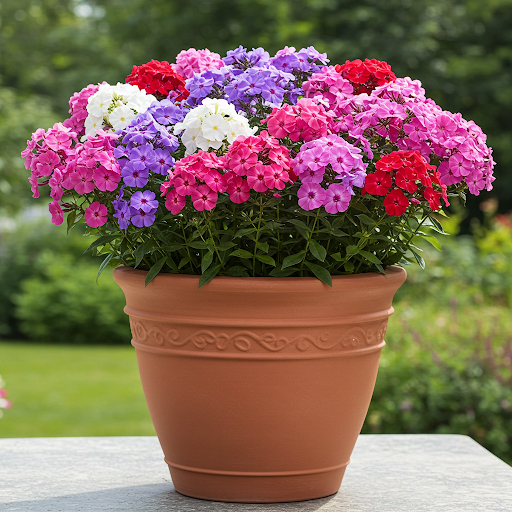
Phlox
In Summary:
Growing Phlox in outdoor pots, especially dwarf Tall Garden Phlox and Creeping Phlox, is a wonderfully rewarding way to add masses of fragrant, colorful blooms and attract butterflies and hummingbirds to your patios, balconies, and gardens. Their long blooming season, diverse colors and habits, adaptability to sunny locations, and relatively easy-care nature make them a perfect choice for container gardeners seeking classic cottage garden charm. By providing full sun to partial shade, rich and well-draining potting mix in pots with drainage, watering to maintain consistent soil moisture, fertilizing regularly during the growing season, deadheading spent flowers (for Tall Garden Phlox), and providing minimal care, you can easily cultivate thriving Phlox plants in pots and enjoy their beautiful, fragrant blooms from spring until fall, year after year for perennial varieties.
For more detailed botanical information and to explore the diverse world of Phlox species and cultivars, you can visit the Wikipedia page on Phlox.
Important Note: Phlox plants are generally considered non-toxic to humans and pets, making them a safe and attractive choice for households with children and animals. The primary care benefits of Phlox in pots are their exceptionally long blooming season, beautiful and fragrant flower clusters in a wide range of colors, and strong attraction to butterflies, hummingbirds, and other beneficial pollinators, bringing life and classic cottage garden beauty to your outdoor spaces for many months. With these simple care practices, you can enjoy a season filled with the enchanting beauty and ecological value of Phlox in your outdoor containers.
KC2-GS
By greenship|2024-08-16T06:30:21+00:00August 16, 2024|Categories: Hand-carving Series|
20T
By greenship|2024-08-13T06:42:22+00:00August 13, 2024|Categories: Hand-carving Series|
KC2-11V
By greenship|2024-08-16T05:39:50+00:00August 16, 2024|Categories: Hand-carving Series|
K2-11T
By greenship|2024-08-13T04:21:25+00:00August 13, 2024|Categories: Hand-carving Series|
KC3-14A
By greenship|2024-08-16T06:26:30+00:00August 16, 2024|Categories: Hand-carving Series|
Modern Plant Pots with Drainage – Indoor & Outdoor Use (6″ Widths)
By greenship-seo|2025-04-10T06:29:43+00:00February 6, 2025|Categories: Hand-carving Series|Tags: Decorative Flower Pots|

